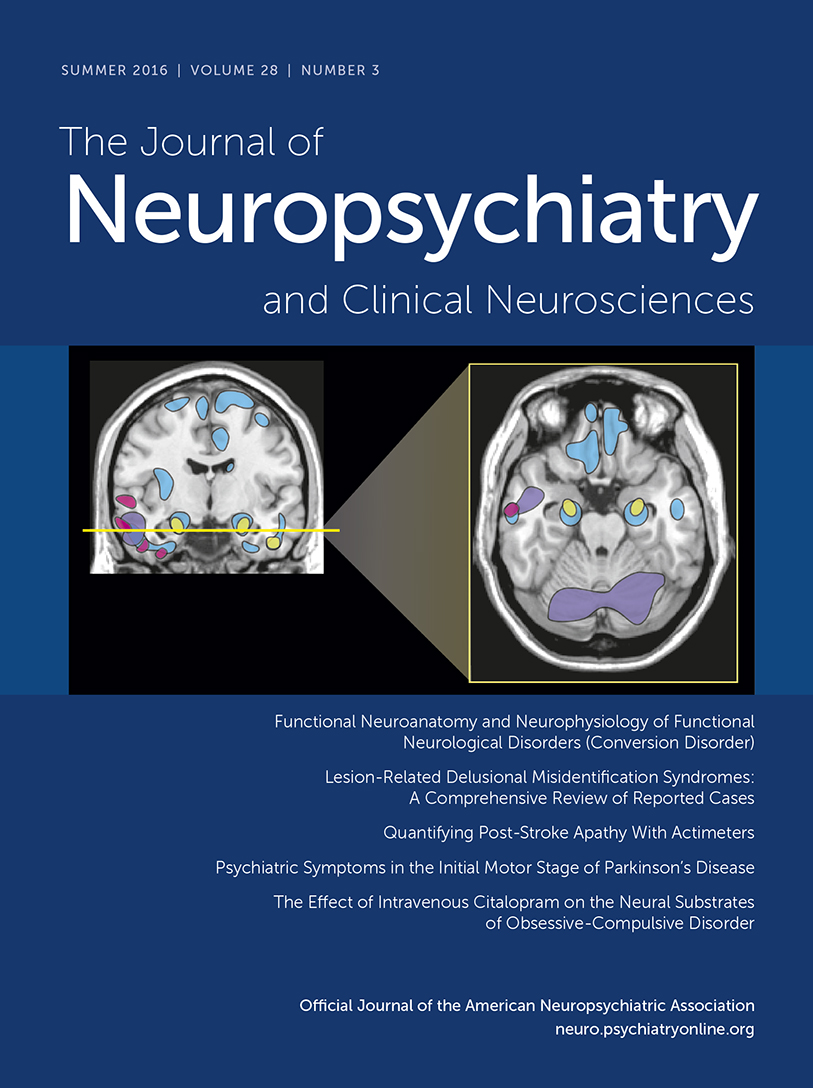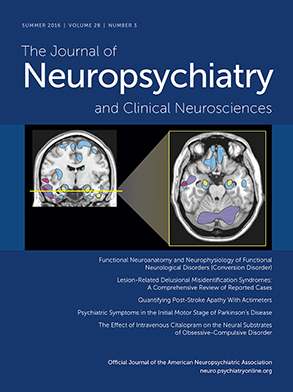The delusional misidentification syndromes—Capgras and Fregoli’s syndromes, erotomania, and others—are uncommon but fascinating neuropsychiatric disorders. All share a common basis featuring a fixed, false belief relating to issues of familiarity regarding social and emotional relationships with others or self. These syndromes have been recognized for more than 100 years, and have been associated with a wide variety of both primary psychiatric and neurologic illness.
1 Although reliable data are not available, estimates of the prevalence of the delusional misidentification syndromes range from 1% to 4% of patients on inpatient psychiatric units to as high as 30% of persons with Alzheimer’s disease.
2Two articles in this issue
3,4 of the
Journal shed new light on these disorders and suggest new avenues for future study. Darby and colleagues
3 present a comprehensive review of reported lesion-related cases with a detailed analysis of clinical course, localization, neuropsychological assessment, and delusional content. In keeping with many clinical observations and prior reviews, these authors found a predilection for right hemisphere involvement, specifically affecting the right frontal lobe in most cases, and prominent memory impairment, executive dysfunction, and visual-spatial problems. Patients rarely had premorbid psychiatric disease, and the most common etiologies were vascular events or trauma. Whereas follow-up data were limited, in many patients the symptoms were self-limited with resolution in 1 to 2 months. Jones and colleagues
4 present a case of Capgras syndrome associated with the persistent tactile sensation of wearing a vest. Neuroimaging demonstrated bilateral injury with right hemisphere predominance. Both articles discuss the relevant neuroanatomy helping to refine our understanding of the delusional misidentification syndromes as resulting from disruption of sensory input from its appropriate social and emotional context, the consequences of which include disturbances of the perception of familiarity, affection, and social connection. These disturbances in turn lead to misinterpretation of relatedness to people and/or places, including misidentifying family and friends as strangers, strangers as family and friends, strange places as familiar and vice versa, as well as disturbances of self-identification. Dysfunction in reality testing, error detection, and error correction facilitate persistence of such delusional beliefs.
As with any neuropsychiatric syndrome, the first step in evaluation and management is detailed observation of the clinical presentation and careful consideration of pertinent neuroanatomic and neurophysiologic findings; these articles admirably advance this objective. While these studies offer some insight into the clinical course and outcome of the delusional misidentification syndromes, however, more detailed studies of natural history are warranted. Few reports provide information that usefully informs the prognosis of patients with delusional misidentification syndromes and that justifies symptom-targeted therapies, including pharmacotherapies.
5 The first and most obvious intervention, of course, is to treat any medical or neurological process driving the development of the delusion, including stroke, infection, tumor, or autoimmune process. More challenging is the treatment of continued delusional misidentification when the primary disease process has been addressed: while many reported patients experienced spontaneous resolution of their delusional misidentification syndromes,
6 these syndromes may persist and entail significant clinical impairment, comorbidity, and forensic consequences.
2,7 Indeed, these syndromes may be associated with marked behavioral disturbances, including agitation and violence.
7 Whereas nonpharmacological treatment with reassurance, redirection, education, and reorientation is of course preferable and may be effective,
6,7 treatment with antipsychotic drugs, other medications, or procedural interventions is often needed for the sake of ensuring safety.
Yet these interventions carry their own risk, and, given that many affected patients are older and have multiple comorbidities, much care should be taken in considering treatment. In the absence of solid evidence regarding the drug treatment of delusional misidentification, the use of nonpharmacological measures is to be preferred. The paucity of data on treatment underscores the need for a better understanding of the natural history of these syndromes, which will in turn permit observations on whether a given pharmacologic treatment, psychotherapy, or procedural intervention enhances recovery more than that expected from supportive therapy alone.
The authors of these articles have made significant contributions to our understanding of the delusional misidentification syndromes, confirming a considerable amount of work done to date and helping refine basic brain-behavior relationships. Armed with a better understanding of the localization and underlying pathophysiology, the time has come for clinicians to work toward a better understanding of the natural history of these syndromes and the clinical outcomes of affected individuals. Only with this knowledge will it be possible to judge the potential salutary and negative effects of treatments intended to improve recovery.

